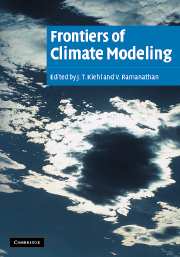Book contents
- Frontmatter
- Contents
- Preface
- List of Contributors
- Acknowledgments
- 1 Overview of climate modeling
- 2 Climate-change modeling: a brief history of the theory and recent twenty-first-century ensemble simulations
- 3 Energy-balance climate models
- 4 Intrinsic climatic variability: an essay on modes and mechanisms of oceanic and atmospheric fluid dynamics
- 5 The radiative forcing due to clouds and water vapor
- 6 A model study of the effect of Pinatubo volcanic aerosols on stratospheric temperatures
- 7 Unresolved issues in atmospheric solar absorption
- 8 Cloud feedbacks
- 9 Water-vapor feedback
- 10 Water-vapor observations
- 11 New frontiers in remote sensing of aerosols and their radiative forcing of climate
- 12 Cloud–climate feedback: lessons learned from two El Niño events
- 13 Runaway greenhouses and runaway glaciations: how stable is Earth's climate?
- Glossary
- Plate section
11 - New frontiers in remote sensing of aerosols and their radiative forcing of climate
Published online by Cambridge University Press: 12 August 2009
- Frontmatter
- Contents
- Preface
- List of Contributors
- Acknowledgments
- 1 Overview of climate modeling
- 2 Climate-change modeling: a brief history of the theory and recent twenty-first-century ensemble simulations
- 3 Energy-balance climate models
- 4 Intrinsic climatic variability: an essay on modes and mechanisms of oceanic and atmospheric fluid dynamics
- 5 The radiative forcing due to clouds and water vapor
- 6 A model study of the effect of Pinatubo volcanic aerosols on stratospheric temperatures
- 7 Unresolved issues in atmospheric solar absorption
- 8 Cloud feedbacks
- 9 Water-vapor feedback
- 10 Water-vapor observations
- 11 New frontiers in remote sensing of aerosols and their radiative forcing of climate
- 12 Cloud–climate feedback: lessons learned from two El Niño events
- 13 Runaway greenhouses and runaway glaciations: how stable is Earth's climate?
- Glossary
- Plate section
Summary
Introduction
As shown in the previous chapter, remote sensing offers a tremendous opportunity in observing Earth's climate system. This chapter further explores the unique capabilities of satellite observations. Remote sensing of aerosol and aerosol radiative forcing of climate is being revolutionized as we write these lines. We are moving from a qualitative global description of the aerosol presence, available now for several years (Jankowiak and Tanré, 1992; Husar et al., 1997; Herman et al., 1997a), to quantitative measurements of laboratory precision (Chu et al., 1998; Tanré et al., 2001). These measurements will not only tell us the aerosol loading or optical thickness (Tanré et al., 1997), but also the aerosol intrinsic optical properties and radiative forcing of climate (Kaufman et al., 2001). The revolution is accomplished by designing and using new satellite sensors (Kaufman et al., 1997b), by re-analyzing images from the old operational sensors using new science understanding (Nakajima and Higurashi, 1998), and by forming a federated network of instruments for ground-based remote sensing of aerosols and their properties (Holben et al., 1998). This maturity of the aerosol remote-sensing science resembles and follows the development in remote sensing of the Earth radiation budget, which pioneered the use of high-precision space-borne and ground-based radiation measurements (Cess et al., 1995; Ramanathan et al., 1989; Wielicki et al., 1996).
Here we summarize two examples that extend remote sensing from the traditional role of qualitative monitoring of the aerosol distribution.
Information
- Type
- Chapter
- Information
- Frontiers of Climate Modeling , pp. 312 - 331Publisher: Cambridge University PressPrint publication year: 2006
